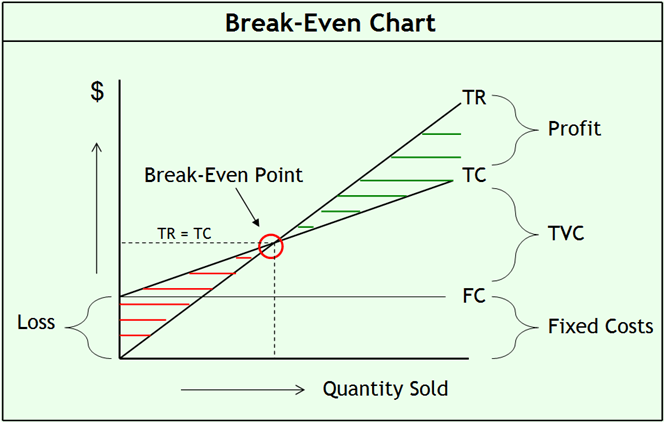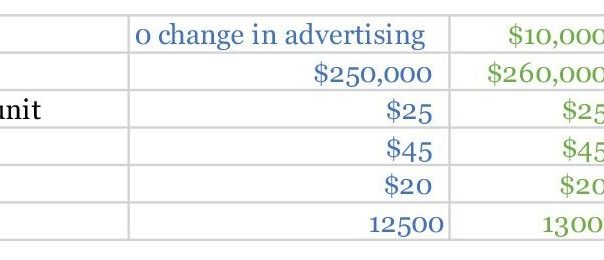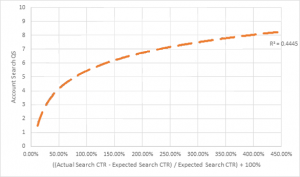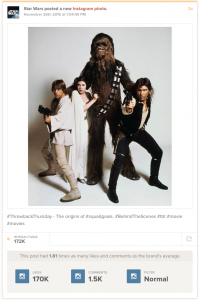Developing a break-even strategy represents the best decision-making tool available to marketers regardless of industry or niche.
As we begin our discussion of how a break-even strategy explodes your business, we need to agree on the definition of break-even then know how we calculate break-even. So, break-even is the point where you’re covering all your costs and not making any money. But, heck, you’re not losing money either and in many businesses, especially early in their lifecycle, just staying ahead of your debt is enough.
Let’s start by building an understanding of break-even analysis and how it’s calculated. For that, I’ve got this great video:
When should you reach break-even?
Exactly when your business hits the break-even point depends on many factors and your ultimate goals shouldn’t be reaching the break-even point quickly. Rather, you want to break-even as soon as it’s reasonably possible.
Let’s take the case of Amazon. I remember back in the late 90s, when I first started teaching e-commerce before it became digital marketing, Amazon predicted they wouldn’t reach break-even until 5 years in the future. The stock market and tech pundits didn’t receive this news with enthusiasm and many predicted the near-term failure of Amazon. Certainly, their announcement made it challenging to raise investment funds, but we all know the end of that story–Amazon now boasts a net worth of over $ 1 trillion.
Taking longer to reach break-even didn’t help Amazon. Instead, their strategic plan called for making a significant investment in the property and equipment needed to support the logistics of an e-commerce brand. In comparison, other e-commerce firms, the darlings of the emerging industry like Pets.com and eToys.com fell into the industry graveyard when the dotcom bust occurred in the early 2000s. These competitors, those we now call pure-play businesses, failed to understand that selling online represented only half the battle and, with razor-thin margins, getting products to customers distinguished success from failure in the early days of e-commerce. Further, competitors fought for the few consumers willing to buy online by offering costly shipping for free, further raising their break-even nut.
How to build your break-even strategy
To be clear, businesses use break-even analysis long after they reach the point where the business makes money. Instead, you should use break-even analysis throughout the life of a business as it faces strategic decisions, such as new products, new channels, and operations facilities. In fact, any anticipated change in the business’s operations warrants a break-even analysis.

I recently worked with a client to help evaluate whether or not to employ a new distribution channel. An intern worked with the company to identify the relevant costs and estimate potential sales. Unfortunately, no one even considered a break-even analysis and how that tool would improve decision-making.
Now, let’s move on to discuss how to build your break-even strategy.
Collect relevant costs
Starting a business involves significant cost and making any change to your business operation incurs costs. Start collecting relevant costs by crafting a business strategy, then costing out all the business inputs you planned, such as hiring staff, manufacturing product, logistics and distribution, and marketing costs.
Once you estimate all your costs, divide them into fixed and variable. Fixed costs occur over time and include costs such as equipment, rent, and salaries. Variable costs change based on how much you sell and examples include shipping costs, sales tax, and materials.
Calculate break-even
Calculations of break-even come from dividing fixed costs by contribution margin, which is the selling price minus variable costs or your profit per unit. If you accurately estimated your costs and broke them into fixed and marginal, this calculation is easy enough for a 5th grader.
Often, break-even strategy requires calculating the break-even point based on both the dollar amount of sales required as well as the number of sales necessary to reach break-even.
Make adjustments
Calculating break-even isn’t hard. But the reality is often different from your assumptions. For instance, you may discount products that don’t sell within a defined time-frame to move old inventory, which is especially true for seasonal products or goods in rapidly changing technological environments, such as mobile devices, products become obsolete quickly and you must reduce the price on obsolete products.
Hence, developing a price estimate may involve multiple price points over the year, which requires some fiddling with the price used in the break-even analysis. Variable costs might also vary over the course of a year, requiring some averaging to accurately calculate the break-even point.
Build a break-even strategy
Once you have your break-even point, develop strategies that budget expenses in line with the figures used in your calculations. For instance, budget an amount for salaries, rent, advertising, and other fixed expenses that doesn’t exceed the fixed cost number used in your calculation.
If making a change to your strategy, calculate the effect of that change on your new break-even point. For instance, in the example I used earlier of a client wanting to add a new channel of distribution, estimate any change in fixed costs, variable costs, and pricing. In the new channel, which involved selling through Amazon, the firm would incur fixed costs in the form of storage fees imposed by Amazon to house their inventory. Variable costs would increase as Amazon assessed a transaction fee for each sale, as well as fees for shipping and handling. Meanwhile, Amazon rules often don’t allow e-commerce partners to charge more for their products sold through Amazon than the lowest alternative channel consumers might use.
Hence, evaluating the opportunity to sell via Amazon involved calculating the break-even point based on the new costs. If the number of sales required far exceeds the new break-even point, then the company should adopt the new channel.
Harness the power of sensitivity analysis
Sensitivity analysis, at its most basic, involves a series of “what-if” games using break-even analysis to build a better break-even strategy. Here’s an example using Excel.
 Image courtesy of Educba
Image courtesy of Educba
In this example, the business uses sensitivity analysis to calculate the NPV (net present value) of returns using 3 different scenarios. A more effective sensitivity analysis uses contribution margin (remember, the contribution margin is the difference between the price and variable costs) to determine the break-even point under different scenarios.
For instance, consider a situation where the company considers changing the amount they spend on advertising. Here’s what that scenario might look like this:

Note, this calculation contains the required number of units to reach break-even. You change that into a monetary figure by multiplying the break-even by the unit price. Hence, in this example, you must sell $ 562,500 in product to reach the break-even point.
Once you have your costs set up in Excel, you can play an infinite number of games with the information, thus crafting your break-even strategy by manipulating strategic options.
Break-even strategy in decision-making
Break-even strategy allows you to plan for as many strategic options as you can imagine. You can use this technique to compare different strategies using the break-even point to guide decision-making. Thus, the strategy resulting in the lowest break-even point is the “winner”.
Of course, determining your marketing and business strategies isn’t a financial exercise alone. Sure, a tool like a break-even analysis provides guidance to help evaluate between alternatives. But, consider the following caveats.
Strategy involves long-term planning
When planning your strategy, consider the long-term rather than short-term returns. This harkens back to our example of Amazon. By taking a long-term view of the company’s strategic future, Amazon made decisions that sacrificed short-term profits by spending significant amounts on building for a robust future by building warehouses in strategically valuable areas of the country to reduce shipping costs and transportation time. This decision positioned them to offer the fastest delivery at lower costs than competitors, which drove customers to their site. Long-term planning also meant Amazon intended to expand beyond books as a profitable strategy from the early days.
Cannibalization is a great example of where long-term planning involves different decisions than short-term optimization. Cannibalization, despite its poor name, involves a company developing a product that takes market share away from its existing products, thus increasing costs. When a firm bases decisions on cannibalization, it must weigh the negative impacts of increased costs and reduced profits from product 1 with the potential for product 2 sales. Cannibalization decisions are a specific type of sensitivity analysis that must look at the change in break-even point while considering what happens over time. For instance, the failure to introduce a new product leaves a firm open to competitors who decide to develop the product. When the consumer market shifts toward the competitor’s product, the firm loses sales of its existing product without the benefit of contravening sales of the new.
Apple faced this problem when they got rid of Steve Jobs over his management of the Macintosh project. Rather than spend lavishly to build a new computer platform, the Apple board decided to invest in an improved version of the Lisa computer. Jobs argued that Apple would lose market share over time with a bigger, better Lisa, and needed a new platform despite the huge cost involved in developing something that pushed the envelope.
After struggling for several years with the poor outcomes of that decision, Apple brought Jobs back and the Macintosh was born. We all know how that decision turned out and contributed to Apple’s success today.
Plan for contingencies
The world has a nasty habit of changing and no year showed businesses that more clearly than 2020. Yet, experts predicted the possibility of a global pandemic for more than a decade, and earlier brushes with a pandemic were proof of the concept. Contingency planning allowed some businesses to pivot quickly into new strategies outside those predicted based on break-even analysis.
Thus, strategic planning involves thinking beyond the numbers to develop plans for an uncertain future.
Conclusion
Using break-even analysis to guide strategic decisions offers a new perspective to evaluate proposed changes or new ventures. However, firms must temper the financial analysis with anticipations related to changes in the status quo and evaluations of the likelihood of these changes.
I’d love to get your thoughts and feedback on the issue of using break-even analyses like those presented here in evaluating proposed decisions within your organization. Post your comments in the section below. Also, if you have ideas for future posts that might benefit your business, feel free to list them below, as well.
Business & Finance Articles on Business 2 Community
(15)





